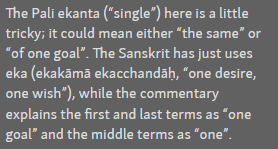I.B. Horner translates aggaḷa as “bolt”, [1] as does Bhikkhu Bodhi in NDB, yet it is far from clear that this is the correct rendering. In a number of places, the Vinaya Piṭaka has a list of door appurtenances. This list includes a fairly detailed description of things that pertain to doors: a door panel (kavāṭa), a lintel (piṭṭha), [2] door posts (saṅghāṭa), a lower hinge (udukkhalika), an upper hinge (uttarapāsaka), a bolt post (aggaḷavaṭṭi), a bolt eye (kapisīsaka), a bolt (sūcika), a lockable bolt (ghaṭika), a keyhole (tāḷacchidda), a door-pulling hole (āviñchanacchidda), and a door-pulling rope (āviñchanarajju). Aggaḷa, however, is conspicuously absent. This makes it unlikely that aggaḷa should simply be equated with “bolt” or any other basic part of a door, especially since the above list contains two words that specifically mean bolt, namely, sūcika and ghaṭika.
Another possible meaning for aggaḷa is “door”, as suggested by DOP. Let’s have a look at some relevant contexts.
“Monks, imagine a light ball of thread placed on an aggaḷa-plank made entirely of heartwood.” [3]
Here it is hard to imagine that aggaḷa could have anything to do with a bolt. That it should refer to a door, however, makes good sense, and aggaḷaphalake would then mean something like a “door-panel.”
At bhikkhu pācittiya 19 aggaḷaṭṭhapanāya is glossed as dvāraṭṭhapanāya. Dvāra unambiguously means “gate” or “door”, and so that must be the meaning of aggaḷa too, at least in this context.
Then we have the fairly common expression aggaḷaṁ ākoteti. It is found, for instance, at DN 3:
“Having entered the porch, having coughed, he knocked the aggaḷa. The Buddha opened the door.” [4]
To translate this as “knocking (on) the door-bolt,” as I.B. Horner does, is not meaningful. “Knocking on the door/door-panel”, however, is straightforward.
The commentaries support this understanding of aggaḷaṁ ākoṭesi:
“The aggaḷa is the door in the doorway.” [5]
“Knocking the aggaḷa means apply a sign on the door with the tip of the nails.” [6]
“Knocking the aggaḷa means knocking (on) the door-panel with the tip of the nails.” [7]
At MN21 we have the compound aggaḷasūci, translated by Ñāṇamoli as “rolling-pin,” but it is hard to see how he might justify this. We have seen above that sūci, when used in conjunction with doors, means “bolt”. If aggaḷa too means “bolt”, the compound would not make sense. If aggaḷa means door, then an aggaḷasūci would be a “door-bolt.” This fits with the story in MN21 where “Mistress Vedehikā” hits her servant Kālī on the head and causes her to bleed.
If we take aggaḷa to mean a door or a door-panel, this also makes sense of the use of aggaḷa as a patch of cloth, as found in the non-offense clause to bhikkhu pācittiya 58 and in the Cīvarakkhandhaka at Mv 2.152. A patch and a panel have much in common, in that they both cover a hole. This explains the shared name. On the other hand, there is no obvious reason why a patch and a bolt would share a name.
I conclude from the above that “door” or “door-panel” is the main meaning of aggaḷa in the Vinaya Piṭaka. There are a few more references to aggaḷa that I have not mentioned, but they do not add much to the above. The only exception is the compound aggaḷaguttivihāro, “a dwelling kept safe by an aggaḷa.” In this case the obvious meaning of aggaḷa is “bolt” or “lock.” But even here it could refer to a door, with the existence of a bolt/lock being implied.
It is this last usage of aggaḷa which perhaps gives us the final clue to its meaning. I would suggest the aggaḷa is a complete door, including all the parts that go into a door. This is why aggaḷa does not appear as a separate part in the list quoted above. This is also why there is no need to mention the lock when a hut is said to be guarded by an aggaḷa – the lock is implied. In contrast, kavāṭa refers to a door-panel, and as such it is included in the door-part list. And a dvāra is a door in the sense of a door-way. It includes grand “doors” such as gates and gateways found at the entry points to villages and towns.
So aggaḷa means “door.” If it ever means “bolt,” this is no more than an extended meaning. It makes sense that this fairly rare word should have only a single overarching meaning rather than two quite distinct ones.
[1] E.g. at BD 2.258 and BD 4.342.
[2] In some cases, however, piṭṭha seems more likely to mean “doorpost” or “doorframe”. Mv 1.81: Mañco nīcaṁ katvā sādhukaṁ appaṭighaṁsantena, asaṅghaṭṭentena kavāṭapiṭṭhaṁ, nīharitvā ekamantaṁ nikkhipitabbo, “Holding the bed low, he should carefully take it out without scratching it or knocking it against the door or the door frame, and he should put it aside.” Perhaps the compound, piṭṭhisaṅghāṭa, simply refers to a doorframe.
[3] MN 3.311: Seyyathāpi bhikkhave puriso lahukaṁ suttaguḷaṁ sabbasāramaye aggaḷaphalake pakkhipeyya .
[4] DN 1.144: Āḷindaṁ pavisitvā ukkāsitvā aggaḷaṁ ākoṭesi. Vivari bhagavā dvāraṁ .
[5] DN-a 1.260: Aggaḷanti dvārakavāṭaṁ.
[6] MN-a 1.273: Aggaḷaṁ ākoṭesīti agganakhena kavāṭe saññaṁ adāsi.
[7] AN-a 9.4: Aggaḷaṁ ākoṭesīti agganakhena dvārakavāṭaṁ ākoṭesi.







